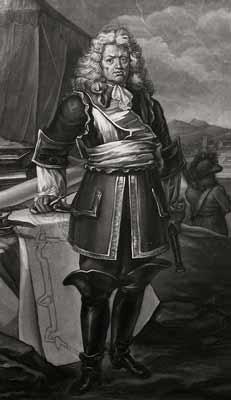Sébastien Le Prestre de Vauban (1633-1707)

Sébastien Le Prestre de Vauban was born on 4 May 1633 in Saint-Léger-de-Foucherets (Morvan). At 18 years of age, he joined Condé’s regiment as a cadet. This was during the time of the Fronde, a series of civil wars in France led by Louis de Bourbon – Le Grand Condé, who won victory at the great Battle of Rocroi in 1643, in the rebellion against the queen regent Anne of Austria and the Austrian prime minister, Cardinal Mazarin.
Vauban joined forced with Mazarin and the young King Louis XIV after Condé's arrest in 1650. He had the opportunity to lead his first siege of the town of Argonne then was appointed, in recognition of the studies he carried out, an engineer to the king in 1655.
Combining theory and practice, he studied the defence problems in the footsteps of engineers who worked on Henry V's fortifications, Errard, Chastillon, de Beins and de Bonnefons. An expert in improving, implementing and erecting fortification systems, he wrote a treatise on the attack of fortresses in 1705.
Named Lieutenant-General in 1688, he was promoted to the dignity of Marshal of France on 14 January 1703. The rest of his career was devoted to the king and his kingdom, building or modernising over 300 fortresses and leading over 50 sieges. His victories are famous and he is credited for capturing Tournai, Douai, Lille, Maastricht, Mons, Besançon, Namur, Luxembourg and others.
In 1673, he fortified the kingdom, which he called the “private reserve”, in Flanders and in the north of France, in Ardennes, Alsace, Rhineland, Franche-Comté, the Alps, Brittany and Roussillon, not to mention the coastline. He created fortifications with parallel series of trenches in Lille, Besançon, Belfort and other sites.
He was a builder, town planner and a military engineer, strategist and tactician, administrator and economist, as well as a civil engineer. He wrote and published his Project for a Royal Tithe in 1707, recommending a flat tax. He also wrote a memoir in 1689 in which he condemned the repeal of the edict of Nantes on the basis of freedom of thought.
Exhausted from a life of huge endeavours, he died on 30 March 1707 in Paris.
His body is buried at the Church of Bazoches (Nièvre) near the château he acquired in 1675, while his heart has lain in the Dome Church at Les Invalides in Paris, the decision of the Emperor Napoleon, since 18 May 1808.
“After God the King is my great example and I will always be happy to carry out his every command.
Even if I have to pay with my own life."
Vauban, letter from Vauban to Chamillart, Paris, 16 January 1706.
Town besieged by Vauban: A captured town.
A town defended by Vauban, an impregnable town.

